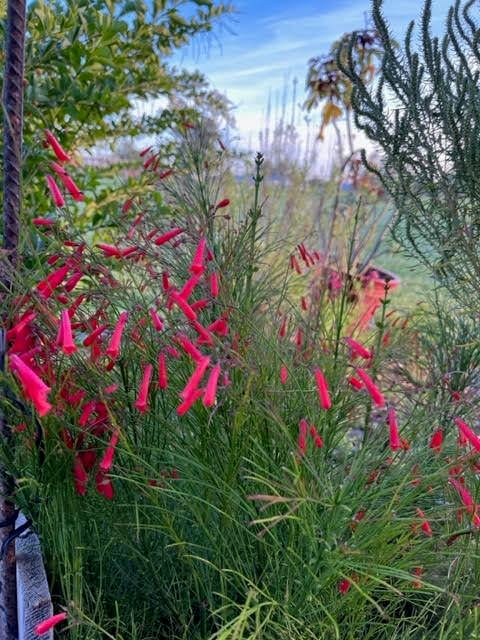Firecracker plant is the newest Texas Superstar
By Suzanne LaBrecque | Victoria County Master Gardener (Read as pdf)

CONTRIBUTED PHOTOS BY VICTORIA COUNTY MASTER GARDENER BRYNN LEE – Firecracker plant at noon

Firecracker plant at noon.

Firecracker plant near dusk

PHOTO CONTRIBUTED BY JOHN FOSSATI Firecracker Fern in container.
Do you love colorful blooming plants that require little pampering? If so, the newest Texas Superstar may be just the one you need. The firecracker plant is a graceful perennial shrub that provides flaming bursts of color from spring to the first frost.
Texas Superstar plants must perform well for gardeners throughout the state. To be labeled a Texas Superstar, plants must be easy to grow, propagate and available for reasonable prices.
Howard Garrett describes the firecracker plants (Russelia equisetiformis) as a “free-flowering tender shrubby perennial (generally root hardy), with rush-like, hanging, almost leafless stems and bright red to orange tubular 1/2-inch-long flowers.” The blooms do look like little firecrackers.
The firecracker plant is also called the Firecracker Fern, Fountain Plant, Coral Plant and Coral Fountain plant. This plant is heat and sun-tolerant, making it a reliable bloomer even in the hottest summers.
It grows well in sun to partial shade. This adaptability makes it possible to move it where needed in the landscape. While it will grow in clay or silt or sand, it needs humus-rich, light, moist and well-draining soil for optimum development.
“The plant grows wider than it does tall due to its spreading nature, making it a fantastic choice for filling in empty spaces to add a bust of color to landscapes,” said Greg Grant.
New growth comes from the roots and the plant spreads about 3 feet wide and 4 feet tall. However, its drooping growth habit makes the plant appear shorter. The stems are not strong enough to support that length causing them to droop.
Newly planted, the firecracker plant has small, round leaves along the thin green stems. As the plant matures, these leaves become insignificant and most drop off. The stems take on photosynthesis and feed the plant.
In addition, the firecracker plants spreading growth lends itself to containers. Their cascading blooms add charming touches of color to outdoor spaces. They also look elegant in hanging baskets that do not require very much space. Stems can be fastened to a wall or trellis taking the colorful blooms upward.
Firecracker plants grow well in the ground or small containers however, larger containers require less maintenance and less watering.
“It looks like a firecracker exploded from the ground and looks equally stunning arching and flowing from a container,” Grant said.
Another advantage of containers is that the plant can be moved indoors during the winter. In the house, firecracker ferns need filtered light and regular fertilizing.
More good news, the firecracker plant has few disease or insect problems. Thus, they are healthy for the growing season.
It prefers low to medium watering making the firecracker plant a good choice for xeriscape gardens. In drought conditions, water plants every few weeks. Unless the plant is wilting, it will be fine.
Once the flowers are spent, shear back the stems to encourage more blooming. In late winter, cut the stems back to about 6-inches or to the ground if there was a winter dieback. This major trimming will reinvigorate the plant.
Sadly, the firecracker plant will not be available in local nurseries until spring. Victoria horticulturist John Fossati said the main drawback with firecracker fern is that it can be invasive. However, like many perennials, he recommends thinning out the clump every few years.
Another benefit is that this plant attracts both butterflies and hummingbirds. With so many positive attributes, no wonder the firecracker plant is a new Texas Superstar.
The Gardeners’ Dirt is written by members of the Victoria County Master Gardener Association, an educational outreach of Texas A&M AgriLife Extension – Victoria County. Mail your questions in care of the Advocate, P.O. Box 1518, Victoria, TX 77901; or [email protected], or comment on this column at VictoriaAdvocate.com.
REFERENCES
Bender, S. editor, The Southern Living Garden Book, Oxmoor House, 1998, pg. 367.
Garrett, H. Plants for Houston and the Gulf Coast, University of Texas Press, 2008, pg. 123.
https://agrilifetoday.tamu.edu (Ignite Gardens with Newest Texas Superstar – the Firecracker plant)
https://www.centraltexasgardener.org (Firecracker Fern)